At this year’s ALSC Global 2024 conference an expert panel discussed mitigation strategies to ensure seamless international part flows in the face of infrastructure constraints, network disruption and a shifting regulatory landscape. Daniel Harrison reports
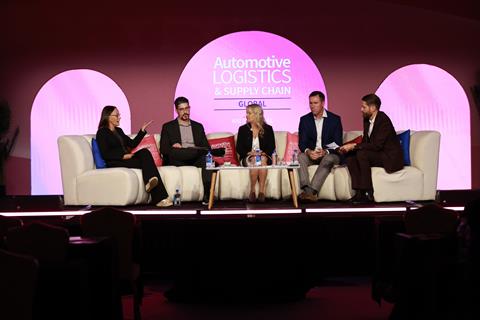
At the Automotive Logistics and Supply Chain Global 2024 conference in Dearborn, Michigan this year, industry experts gathered to discuss pressing issues around automotive cross-border logistics, which is complex and demands greater investments in infrastructure, technology and human capital. Ryder Supply Chain Solutions has made substantial investments to facilitate seamless operations between the US and Mexico according to Frank Bateman, vice-president supply chain at the logistics provider.
“First and foremost, we invested in our infrastructure, so we’ve got a new 250,000 sq.ft [23,225 sq.m] cross dock in Laredo, Texas [and] we’ve got a new 50,000 sq.ft dock in El Paso, Texas, on the Mexico side in Nuevo Laredo,” Bateman explained.
Ryder’s investment also includes increasing trailer yards, truck maintenance yards and office space. However, investment is not just about hardware assets but also about the workforce, as Bateman elaborated: “We’ve also invested in our talent. We’ve hired additional bilingual cross-border professionals. They’ve got experience in all areas of cross-border logistics, customs brokerage, transportation and distribution management.”
Jessica Hanson, vice-president of logistics at Bosch North America, reinforced the importance of continuous investment, particularly in digitalisation and collaboration with supply chain partners. However, investment in technology without collaboration weakens the ability to effectively mitigate risks when disruptions occur. “So, in addition to the automation and the visualisation of our end-to-end supply chain, which is critical, I think another aspect, which is very important, is to maintain very strong collaboration with all of our supply chain partners,” she said.
Sean Leary, general manager automotive and mobility at DSV, also underscored the importance of team collaboration when investing in warehouse and trucking near the US southern border. “We’re investing in people and process. We’re creating a streamlined cross-border product where we bring together our air and ocean teams, our road team, our warehouse team, and then we overlay it with an operational control tower at the border,” he said, adding that it enabled a seamless flow across borders.

A balancing act on the border
Cross-border logistics within North America involves navigating multiple challenges, from security concerns to labour shortages and regulatory complexities. The panel identified the US-Mexico border as a particular point of concern. Jessica Hanson described the border as being in a ‘yellow’ status –indicative of the recurring issues it faces such as “security issues, capacity constraints, labour shortages, immigration and geopolitical risks,” Hanson explained.
Frank Bateman shared a similar perspective, noting that recent events, such as customs system outages, protests and weather-related disruptions at key border points like Laredo, are now common occurrences. “In August and September, there were protests at the Arco Norte highway,” he recouonted. “In September, there were electrical issues at Laredo’s Columbia port. And even a week ago, there was weather damage to Laredo’s world trade bridge, which caused delays.”
Bateman also stressed that government coordination between federal and state agencies is essential in addressing these disruptions, particularly when conflicting policies exacerbate delays, “We need them to come together and work in conjunction between the federal and the state government,” he said.
Sean Leary added that DSV was seeing early signs of congestion at the northern US-Canada border as a result of diverted shipments because of the (then) looming threat of strikes on the US east coast, including backlogs on rail and potential border congestion on northern border roads and DSV was preparing for that. As it turned out, the strike was called off on October 4.
Nevertheless, strikes represent one of the most pressing threats to cross-border logistics. Hanson explained that even a one or two-day strike could lead to weeks of recovery time.
Frank Bateman pointed out that Ryder has been securing additional warehouse space in north Mexico to accommodate the growing demand for nearshoring. “Nearshoring in North America, is driving more cross-border logistics in many instances,” Bateman observed. To prepare for this, Ryder is increasing its warehousing capacity in Monterrey and other northern Mexico locations to support growing inventory needs.
Leary also commented upon the clear correlation between investment in systems, visibility and nearshoring. “The other thing there is it’s also connecting our systems, so we’re giving better real-time visibility to our customers,” he said. “And again, that’s not just unique to us, that’s, I think, the industry in general. But we’re definitely investing in that area because of the nearshoring and just the potential there,” said Leary.
Adapting to regulatory change
International logistics has grown more complicated, driven by regulatory changes, nearshoring trends and just-in-case inventory management strategies. Hanson highlighted the challenge of adapting to an ever-changing regulatory landscape, describing how the constant changes in regulations required Bosch to adapt quickly, even having to retool processes on the fly in some cases.

Skotti Fietsam senior vice-president of supply chain at Accuride, pointed out that global supply chains are experiencing disruptions beyond the US east coast strike threat, and congestion on the west coast, where a lot of product has been shifted there. “Even if there’s not a strike, I’m not done watching the Red Sea,” she said. “I don’t think it’s as heated as prior, but we definitely do have to divert from the Red Sea, and, you know, 27% of all trade goes through the Red Sea,” Fietsam explained. She also referenced the Panama Canal, where ongoing dredging work has forced many companies to divert their shipments to other routes, adding complexity to the global logistics network.
Looking forward from a global perspective, Leary predicted that more challenges lie ahead. “With the global market in general, we’re going to see a big capacity constraint potentially, and then much higher rates.”
Network disruptions and constraints
The panellists agreed that disruptions are becoming more frequent and unavoidable, with strikes, weather-related issues and political events all contributing to delays. Leary emphasised that DSV’s investment in predictive analytics has been instrumental in mitigating these challenges. “We’re using predictive analytics to determine ETAs and those are, we’re finding, more accurate than the information we’re actually getting from the carrier and we’re getting those updates quicker,” Leary said. By using more accurate real-time data, companies can plan around disruptions much more effectively.
Bateman explained that Ryder has taken similar steps to address the complexities of US-Mexico trade flows. “Ryder handles about 250,000 border crossings between the US and Mexico every year. It’s a pretty complicated process. There’s a lot of players involved,” he noted. To streamline these operations, Ryder has rewritten work instructions for border carriers and developed best-in-class CT-PAT (Customs-Trade Partnership Against Terrorism) inspections, reducing trailer dwell time and minimising disruptions.
With the rise of nearshoring, many suppliers are setting up operations in Mexico, but often lack the knowledge and experience needed to navigate cross-border logistics. Hanson noted that Bosch invests considerable resources in educating its supply chain partners on compliance requirements. “With near shoring, we’ve seen a significant increase in suppliers establishing operations in Mexico, and they don’t understand the Immex or Prosec or USMCA rules and regulations,” she said. “So we invest a lot of our own time just consistently educating all of these parties that are involved in the process.”
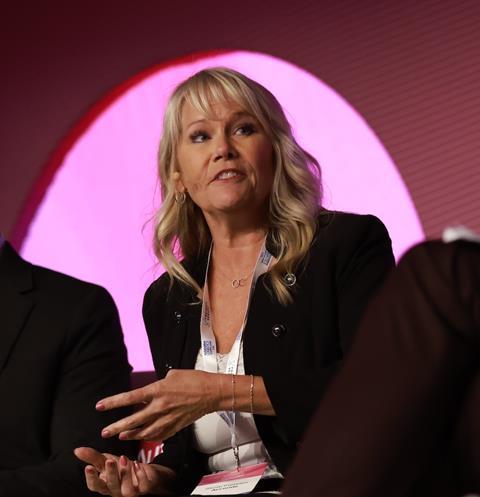
Fietsam shared a similar experience, noting that Accuride has overhauled its systems to manage the complexities introduced by regulations such as the USMCA trade agreement. “We’ve had to develop new systems to be able to handle those intricacies, as well as hire consultants from some of the governmental agencies and our partners, because you just can’t possibly learn all that and know all of it,” Fietsam admitted. Training is therefore a critical component of this, as new regulations continue to emerge, adding complexity to the process.
Tariffs on trade
Navigating the complexities of tariffs and regulations remains a major challenge for companies operating in North America. Hanson underscored that tariffs, particularly those imposed since 2018, have driven significant increases in supply chain costs. “We all know how increases in tariffs have impacted North America, especially since 2018,” she said. “That drives significant costs to the supply chain. It potentially drives additional needs for nearshoring, which then in consequence, saturate and create capacity constraints at the borders.”
The panellists also discussed the regulatory challenges posed by the USMCA, particularly in relation to rules of origin and value-added steps in the production process. Fietsam highlighted how Accuride has had to implement new systems to ensure compliance with these rules. “We’ve had to change systems. For example, if we get a product from two different countries, then we have to have two countries of origin, and then it gets deeper,” she explained. “It’s not just that country.”
She elaborated that iron ore from South Korea became steel from China for stamping into a partand every one of those value-added steps is different in terms claims against the USMCA.
Proactive planning and contingencies
Proactive planning emerged as a central theme during the discussion, with panellists agreeing that mitigation strategies are essential in maintaining seamless operations. “We focus on various types of contingency plans, everything from diversification of our routes, of our modes of transportation, diversification of our carrier base, of the ports of entries that we’re using; even diversification of our supply base and dual or triple sourcing of products,” Hanson revealed. She also highlighted the importance of scenario planning and predictive tools in identifying and mitigating risks early on. Furthermore, Hanson discussed inventory strategies and the merits of modal shifts in a pragmatic manner. “But at the end of the day, it’s really a case-by-case cost and risk analysis,” she said. “In addition to that, we focus even more on diversifying that risk as much as possible through different carriers, different ports of entry, different modes of transportation,” Hanson concluded.
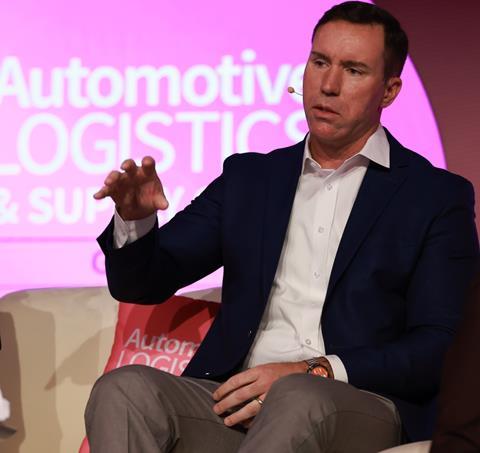
Fietsam observed how Accuride had previously tried to reduce the number of suppliers, but the current strategy was to do the exact opposite. “We can’t really rely on just-in-time delivery like we used to, so I think that’s a big change in terms of contingency plan, making sure you do have your backup suppliers in that case, and also backup routes, other alternatives. I think those are the key points,” said Fietsam.
Frank Bateman elaborated on Ryder’s investment in digital tools to enhance visibility and manage disruptions. “From an end-to-end visibility standpoint, we focus more on the trailer GPS than the tractor GPS. That way it’s tied more to the customer shipment rather than the carrier’s truck,” Bateman explained. This approach allows Ryder to react swiftly to disruptions, ensuring minimal impact on supply chains.
Fietsam also revealed Accuride’s digitalisation journey from previously relying upon Excel spreadsheets to now embracing real-time visibility solutions incorporating AI. “We chose a provider that was a little more adaptable and customised to our needs. In fact, they were the one company that has native AI in their product versus others that would have to do bolt-on AI,” she explained. “Using this company and going forward with a visual system that at any moment in time, I can see where all the shipping containers are at once, is a real advantage to answering my customers’ questions,” Fietsam explained.
However, striking a more cautionary tone, DSV highlighted the potential pitfalls of digitalisation tools.
“There’s a lot of shiny tools and software out there and we’ve seen a lot of it work but there’s also, some cautionary tales because they’re complex and they’re only as good as the data that you put into them,” said Leary. “The bigger and more complex your supply chain, the more difficult it is to give those tools the correct amount of data.”
Cross-border resilience
The complexities of cross-border logistics, particularly in the automotive industry, continue to rise as companies face increasing regulatory requirements, strikes, capacity constraints and geopolitical risks. However, as the ALSC Global panellists demonstrated, proactive investment, digitalisation and collaboration with supply chain partners are crucial proactive strategies stakeholders can take in overcoming the myriad of challenges.
Whether through predictive analytics, real-time visibility tools or investments in infrastructure and talent, the automotive industry is actively seeking ways to build more resilient supply chains. As the demand for cross-border logistics grows, particularly with the rise of nearshoring, companies must stay agile and ready to adapt to the ever-evolving logistics landscape.
By focusing on investment, education and proactive planning, the automotive industry is positioning itself to navigate the challenges of today while preparing for the uncertainties of tomorrow. The insights shared during this conference provide a roadmap for ensuring that the seamless flow of parts across borders continues, even in the face of rising complexity.
At next week’s Automotive Logistics and Supply Chain Mexico conference, which takes place between November 12-14, speakers from AMIA,
Brose, Hellmann Worldwide Logistics and Uber Freight will discuss how manufacturers, logistics providers and border agencies are working to improve international parts flows and investing in facilities, fleets, technology and partnerships






























![Mexico[1]](https://d3n5uof8vony13.cloudfront.net/Pictures/web/a/d/s/mexico1_22990.svgz)
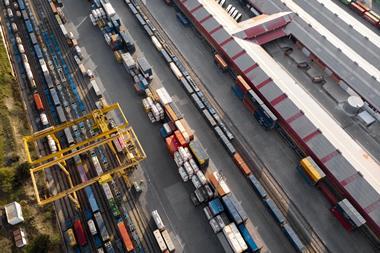

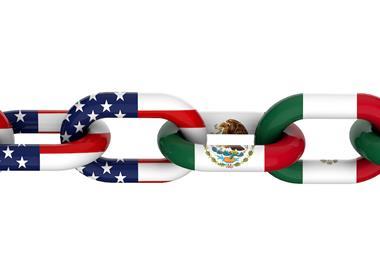






No comments yet